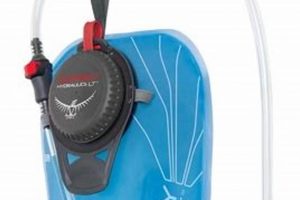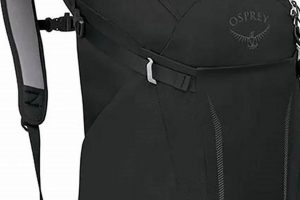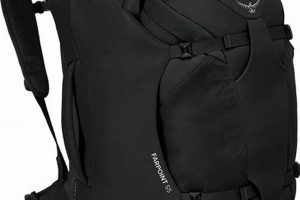Children’s carrying solutions designed and manufactured by Osprey, a company renowned for its outdoor gear, provide a comfortable and functional means for young individuals to transport their belongings. These specialized packs incorporate features such as adjustable harnesses and ergonomic designs tailored to smaller frames. An example would be a lightweight pack designed for elementary school students carrying books and lunch.
The advantages of utilizing appropriately sized and designed carrying equipment for children include promoting proper posture and reducing the risk of strain or injury associated with carrying heavy loads. Historically, children often carried items in makeshift or ill-fitting bags, potentially leading to discomfort or physical issues. The advent of child-specific packs represents an advancement in prioritizing the well-being and ergonomic needs of young users.
The following sections will delve into the specific features, sizing considerations, and selection criteria relevant to choosing a suitable carrying solution for children, ensuring a secure and comfortable experience.
Selection and Usage Guidance
This section provides guidance on selecting and utilizing children’s carrying equipment. Proper fit and loading are critical to ensure comfort and prevent potential strain or injury.
Tip 1: Prioritize Proper Fit. Measure the child’s torso length to determine the appropriate pack size. A pack that is too long or too short will not distribute weight effectively.
Tip 2: Adjust the Harness System. Ensure the shoulder straps are properly adjusted so the pack sits comfortably on the back without digging into the shoulders. The sternum strap should be fastened to prevent the shoulder straps from sliding off.
Tip 3: Distribute Weight Evenly. Place heavier items closer to the child’s back to maintain balance and minimize strain. Avoid packing heavy items at the bottom of the pack.
Tip 4: Limit the Load Weight. The total weight of the pack should not exceed 10-15% of the child’s body weight. Regularly assess the contents and remove unnecessary items.
Tip 5: Utilize Compression Straps. Employ compression straps to stabilize the load and prevent items from shifting during movement. This contributes to a more comfortable and balanced carry.
Tip 6: Consider Hydration. Choose a pack with hydration reservoir compatibility to encourage fluid intake throughout the day. Ensure the reservoir is filled appropriately and cleaned regularly.
Tip 7: Regularly Inspect the Pack. Check for any signs of wear and tear, such as frayed straps or broken buckles. Address any issues promptly to ensure the pack remains safe and functional.
Adhering to these guidelines will contribute to a more comfortable and safer experience for the child, reducing the risk of discomfort or potential injury associated with carrying loads.
The following sections will provide a detailed overview of maintenance procedures and warranty information for children’s carrying equipment.
1. Ergonomic Design
Ergonomic design is paramount in the development of children’s carrying equipment. It directly impacts the comfort, safety, and overall well-being of the young user. The implementation of ergonomic principles in the design phase aims to mitigate potential strain and promote healthy posture.
- Contoured Shoulder Straps
Contoured shoulder straps are engineered to distribute weight evenly across the shoulders and upper back. This design minimizes pressure points and prevents chafing. For instance, wider, padded straps reduce the likelihood of digging into sensitive areas, particularly when the pack is fully loaded. Properly contoured straps contribute to a more comfortable carrying experience, especially during extended periods of use.
- Adjustable Torso Length
Adjustability in torso length is a critical ergonomic feature, accommodating the varying and rapidly changing physiques of children. This allows the pack to be customized to fit the individual’s specific body dimensions. An improperly sized pack can lead to uneven weight distribution and increased strain. Adjustable torso lengths ensure the load is supported appropriately, regardless of the child’s height or build.
- Lumbar Support
Integrated lumbar support helps to transfer a portion of the pack’s weight to the hips, relieving pressure on the spine. This is particularly important when carrying heavier loads. A well-designed lumbar pad conforms to the natural curvature of the lower back, providing additional stability and reducing the risk of back pain or discomfort. Proper lumbar support promotes better posture and reduces fatigue.
- Ventilation Systems
Ventilation systems, such as mesh panels on the back panel and shoulder straps, enhance breathability and minimize perspiration build-up. This helps to regulate body temperature and prevent discomfort, particularly during physical activities. Adequate ventilation contributes to a more pleasant carrying experience by reducing moisture and promoting airflow, preventing overheating and skin irritation.
The incorporation of these ergonomic design elements in children’s carrying solutions reflects a commitment to prioritizing the user’s comfort and well-being. By addressing the unique needs of young individuals, these designs contribute to a safer and more enjoyable experience, fostering healthy habits and minimizing potential risks associated with carrying loads.
2. Adjustable Torso
The adjustable torso feature is an integral component in the design and functionality of children’s carrying equipment. This adjustability directly addresses the variable torso lengths inherent in growing children, allowing a single pack to accommodate a wider range of heights and body types. Its presence ensures that the carrying load is distributed optimally across the child’s back and shoulders, rather than being concentrated in one area due to an improperly sized pack. For instance, a child with a shorter torso using a pack without adjustability could experience the load sitting too low, potentially leading to slouching and back strain. Conversely, a child with a longer torso might find the shoulder straps digging into their shoulders if the pack is too short.
Real-world applications of adjustable torso features are evident in the diverse range of children’s activities. Whether it is for carrying schoolbooks, hiking gear, or travel essentials, the ability to fine-tune the pack’s fit ensures comfort and stability during movement. This feature extends the lifespan of the pack, as it can adapt to the child’s growth over a period, delaying the need for frequent replacements. Furthermore, retailers often highlight the adjustable torso as a key selling point, emphasizing the pack’s adaptability and value for parents seeking a long-term solution.
In summary, the adjustable torso is not merely a supplementary feature but a foundational element in the design of children’s carrying solutions. It directly influences the comfort, safety, and ergonomic benefits of the product. Challenges remain in ensuring parents accurately measure their child’s torso and understand how to properly adjust the pack. However, recognizing the practical significance of this feature underscores its importance in promoting healthy carrying habits and preventing potential musculoskeletal issues in young users.
3. Hydration Compatibility
Hydration compatibility in children’s carrying equipment, specifically in products such as those offered by Osprey, is a design feature of notable practical importance. The integration of hydration systems, commonly consisting of a reservoir pocket and hose routing, addresses a fundamental need for maintaining adequate fluid intake, particularly during physical activity. Failure to incorporate this feature would necessitate children carrying separate water bottles, potentially adding bulk, increasing the risk of spills, and hindering accessibility during movement. The presence of a dedicated hydration system streamlines the process, allowing for hands-free hydration and promoting consistent fluid consumption throughout the day. For instance, a child engaged in a hiking activity equipped with an Osprey pack featuring hydration compatibility can easily access water without interrupting their momentum or requiring assistance from an adult.
The benefits of integrating hydration compatibility extend beyond mere convenience. By encouraging frequent water consumption, these systems contribute to improved cognitive function, enhanced physical performance, and reduced risk of dehydration-related health issues. The design consideration also reflects an awareness of the unique needs of young users, who may be less likely to prioritize hydration on their own. Osprey’s implementation often includes features such as insulated hose sleeves to maintain water temperature and bite valves with shut-off mechanisms to prevent leaks. These details demonstrate a comprehensive approach to providing a user-friendly and effective hydration solution. For example, during a school field trip, a child with a hydration-compatible pack is more likely to stay hydrated, thus maintaining focus and energy levels, compared to a child relying on sporadic water breaks.
The incorporation of hydration compatibility into children’s packs represents a deliberate effort to enhance both usability and health-promoting functionality. This feature, while seemingly straightforward, has far-reaching implications for the well-being and performance of young users. Challenges in maintaining these systems, such as cleaning and preventing mold growth, must be addressed through appropriate product design and user education. However, the overall value proposition remains compelling, solidifying hydration compatibility as a critical component of modern children’s carrying equipment.
4. Weight Distribution
Weight distribution is a critical factor in the design and use of children’s carrying equipment, directly influencing comfort, posture, and the prevention of musculoskeletal strain. When considering an “osprey kids backpack,” understanding the principles and practical application of proper weight distribution is paramount for ensuring a safe and comfortable experience for the young user.
- Center of Gravity Alignment
Maintaining the center of gravity close to the child’s spinal axis is essential for stability and balance. An “osprey kids backpack” designed with internal compartments and compression straps aids in positioning heavier items closer to the back, minimizing the lever arm effect and reducing strain. For instance, textbooks should be placed nearest the back panel, while lighter items occupy outer compartments. Failure to do so can result in an unbalanced load, requiring the child to compensate by leaning forward, leading to potential back pain and postural issues.
- Load Stabilization Through Compression
Compression straps play a significant role in stabilizing the load within an “osprey kids backpack”. These straps, when properly tightened, prevent items from shifting during movement. This stabilization contributes to a more balanced and controlled carrying experience. An example includes tightening side compression straps to secure water bottles or lunch containers, preventing them from swaying and disrupting the child’s balance. Without effective compression, the shifting weight can lead to instability and increased energy expenditure.
- Shoulder Strap and Hip Belt Load Transfer
The design of shoulder straps and, in some larger “osprey kids backpack” models, hip belts facilitates the transfer of weight from the shoulders to the stronger muscles of the hips and core. Padded shoulder straps distribute weight evenly, preventing pressure points and chafing. A properly fitted hip belt, if present, transfers a portion of the load to the hips, further reducing strain on the back and shoulders. An improper fit or lack of a hip belt in heavier loads can lead to disproportionate weight bearing on the shoulders, causing discomfort and potential muscle fatigue.
- Weight Limit Considerations
Adhering to recommended weight limits is crucial for preventing overload and minimizing the risk of injury. The total weight of an “osprey kids backpack” should not exceed 10-15% of the child’s body weight. Regularly assessing the contents and removing unnecessary items is essential. Overloading the pack compromises weight distribution and increases the risk of musculoskeletal strain. For instance, carrying excessive textbooks or unnecessary items can significantly increase the load, negating the benefits of even the best-designed weight distribution features.
Effective weight distribution in an “osprey kids backpack” is a multi-faceted concept encompassing center of gravity alignment, load stabilization, appropriate load transfer, and adherence to weight limits. By carefully considering these factors, parents and caregivers can ensure that the child is carrying their belongings in a manner that promotes comfort, prevents injury, and supports healthy posture. This understanding is essential for maximizing the benefits of a well-designed pack and safeguarding the child’s physical well-being.
5. Durable Materials
Durable materials are a fundamental component in the construction of an “osprey kids backpack”, directly influencing its longevity, performance, and ability to withstand the rigors of daily use by children. The selection of robust fabrics and hardware is not merely a matter of aesthetic appeal; it is a critical factor in ensuring that the pack can endure the stresses of carrying heavy loads, resisting abrasion, and withstanding exposure to varying environmental conditions. The use of substandard materials in a children’s carrying solution can result in premature wear and tear, seam failures, and compromised structural integrity, ultimately rendering the pack unusable and potentially unsafe. An example would be a pack constructed with low-denier polyester that quickly develops holes and tears under normal use, necessitating frequent replacements.
Osprey, as a manufacturer, often employs high-tenacity nylon and reinforced stitching in its children’s backpack lines, reflecting an understanding of the demands placed on these products. These materials exhibit superior tear resistance, abrasion resistance, and water repellency compared to less durable alternatives. Furthermore, hardware components such as zippers, buckles, and adjusters are typically selected for their strength and reliability. The practical significance of this material selection becomes evident in real-world scenarios, such as a child using the pack daily for school, transporting books and supplies, or during outdoor activities where the pack may be subjected to rough handling. The pack’s ability to withstand these conditions without significant damage is a direct consequence of the durable materials used in its construction. Investing in a pack constructed with durable materials, despite a potentially higher initial cost, can result in long-term cost savings by reducing the frequency of replacements.
In summary, the incorporation of durable materials is a defining characteristic of a high-quality “osprey kids backpack”. This aspect extends beyond mere marketing claims; it is a measurable attribute that directly impacts the product’s lifespan, performance, and overall value proposition. Challenges remain in educating consumers about the specific material properties and construction techniques that contribute to durability. However, understanding the critical link between durable materials and the long-term usability of a children’s carrying solution is essential for making informed purchasing decisions and ensuring the safety and well-being of the young user.
6. Safety Features
The integration of safety features within children’s carrying equipment, such as an “osprey kids backpack,” represents a critical design consideration. These features aim to enhance visibility, mitigate potential hazards, and promote responsible usage. The subsequent points outline essential safety aspects integrated into these products.
- Reflective Elements
Reflective elements serve to increase the visibility of the child, particularly during periods of low light or darkness. These elements, often strategically placed on the pack’s exterior surfaces, reflect light from external sources such as vehicle headlights. For instance, reflective strips on the shoulder straps and back panel enhance visibility when the child is walking near roadways or in dimly lit areas. The absence of such features can significantly reduce the child’s visibility, increasing the risk of accidents. A practical example is an “osprey kids backpack” equipped with high-visibility reflective accents, enabling drivers to easily spot the child from a distance during early morning or late afternoon commutes.
- High-Visibility Colors
The use of high-visibility colors, such as bright yellow, orange, or green, further enhances the child’s conspicuity. These colors are easily discernible, even under suboptimal lighting conditions. A brightly colored “osprey kids backpack” stands out against various backgrounds, making the child more noticeable to motorists, cyclists, and pedestrians. This is especially relevant in environments with heavy traffic or limited visibility. The selection of vibrant colors is a proactive safety measure, supplementing reflective elements and contributing to overall visibility.
- Emergency Whistle
An integrated emergency whistle provides a means for the child to signal for assistance in the event of an emergency. Typically attached to the sternum strap or another readily accessible location, the whistle allows the child to attract attention if they become lost, injured, or encounter a dangerous situation. The presence of an emergency whistle empowers the child to take action and seek help when needed. For instance, if a child becomes separated from their group during a hike, they can use the whistle to alert others to their location. This simple yet effective feature can be crucial in emergency situations.
- Breakaway Sternum Strap
A breakaway sternum strap is designed to detach under significant force, preventing potential choking or entanglement hazards. This feature is particularly important for younger children who may be more prone to accidents involving straps or cords. If the child’s sternum strap becomes caught on an object, the breakaway design allows it to release automatically, minimizing the risk of injury. An “osprey kids backpack” incorporating a breakaway sternum strap provides an added layer of safety, ensuring that the strap does not pose a strangulation hazard.
These safety features, when effectively implemented in an “osprey kids backpack,” contribute to a safer and more secure experience for the child. They represent a commitment to prioritizing the well-being of young users and mitigating potential risks associated with carrying equipment. Continual advancements in safety technology and design are essential for further enhancing the safety aspects of children’s carrying solutions.
7. Age Appropriateness
The concept of age appropriateness is a pivotal consideration in the design and selection of an “osprey kids backpack”. The cause-and-effect relationship between improper sizing and a child’s physical well-being is significant. A pack that is too large can lead to postural problems, muscle strain, and discomfort due to uneven weight distribution. Conversely, a pack that is too small may not adequately accommodate necessary items, forcing the child to carry additional loads in an unsafe manner. The importance of age appropriateness as a component of the “osprey kids backpack” is underscored by the need to align the pack’s features, size, and weight capacity with the child’s developmental stage and physical capabilities. For example, a preschooler requires a smaller, lighter pack with simplified features compared to a middle school student who may need a larger pack with more organizational compartments and durable construction to accommodate heavier textbooks.
Real-life examples illustrate the practical significance of understanding age appropriateness. A younger child struggling with a pack designed for older children might exhibit slumped posture, difficulty maintaining balance, and complaints of shoulder or back pain. An older child using a pack designed for younger children might find it inadequate for their needs, leading to frustration and potential damage to the pack itself. From an informational perspective, Osprey likely designs different pack models with distinct features tailored to specific age ranges, considering factors such as torso length, weight capacity, strap adjustability, and safety features like breakaway sternum straps for younger children. The practical application extends to parental guidance, informing them on how to assess proper fit and weight limits based on their child’s age and physical development.
In summary, age appropriateness is not merely a marketing term but a critical design and selection criterion for an “osprey kids backpack”. It directly impacts the child’s comfort, safety, and long-term musculoskeletal health. The challenge lies in providing clear and accessible information to parents, enabling them to make informed purchasing decisions and ensure that the chosen pack aligns with their child’s specific needs. By prioritizing age appropriateness, manufacturers and consumers alike contribute to promoting healthy carrying habits and preventing potential physical issues in young users.
Frequently Asked Questions
The following addresses common inquiries regarding the selection, use, and maintenance of carrying solutions designed for young individuals.
Question 1: What constitutes an appropriate weight limit for a child’s carrying pack?
The total weight of the pack, including all contents, should not exceed 10-15% of the child’s body weight. Exceeding this limit can lead to musculoskeletal strain and discomfort.
Question 2: How can the proper torso length be determined when selecting a pack?
Measure the distance from the child’s C7 vertebra (the prominent bone at the base of the neck) to the iliac crest (the top of the hip bone). This measurement provides an approximation of the required torso length.
Question 3: What are the essential features to consider for children’s carrying solutions?
Key features include adjustable torso length, padded shoulder straps, a sternum strap, compression straps, durable materials, and reflective elements for enhanced visibility.
Question 4: How frequently should a child’s pack be inspected for wear and tear?
Regular inspections should be conducted at least monthly, or more frequently if the pack is subjected to heavy use. Pay particular attention to seams, zippers, buckles, and straps.
Question 5: What are the recommended methods for cleaning and maintaining children’s carrying equipment?
Consult the manufacturer’s instructions for specific cleaning guidelines. Generally, hand washing with mild soap and water is recommended. Avoid using harsh chemicals or machine drying, as these can damage the materials.
Question 6: What steps should be taken if a child experiences discomfort or pain while using a carrying pack?
Immediately remove the pack and assess the fit and weight distribution. Adjust the straps as needed and ensure that the load is properly balanced. If discomfort persists, consult a healthcare professional.
Proper selection, fit, and usage are crucial for ensuring the comfort and safety of children using carrying equipment. Regular maintenance and adherence to weight limits contribute to the longevity of the pack and the well-being of the user.
The subsequent sections will delve into detailed maintenance procedures and warranty information pertaining to children’s carrying solutions.
Conclusion
The preceding exploration has elucidated the multifaceted considerations surrounding the “osprey kids backpack.” From ergonomic design principles to the critical importance of age-appropriate sizing and the integration of safety features, it becomes clear that the selection and utilization of such equipment warrants careful attention. Proper weight distribution, durable material construction, and readily accessible hydration systems further contribute to the overall efficacy and well-being of young users.
Therefore, informed decision-making in this area is not merely a matter of convenience, but one of responsibility. A commitment to prioritizing the physical health and safety of children necessitates a thorough understanding of the factors discussed herein. Future advancements in material science and ergonomic design hold the potential to further enhance the functionality and safety of children’s carrying equipment, underscoring the continued significance of this field.







![Best Osprey Kestrel 38L Backpack [Review & Guide] Ultimate Backpack Traveler Guide: Tips, Destinations & Budget Hacks Best Osprey Kestrel 38L Backpack [Review & Guide] | Ultimate Backpack Traveler Guide: Tips, Destinations & Budget Hacks](https://backpack-traveler.com/wp-content/uploads/2025/10/th-816-300x200.jpg)